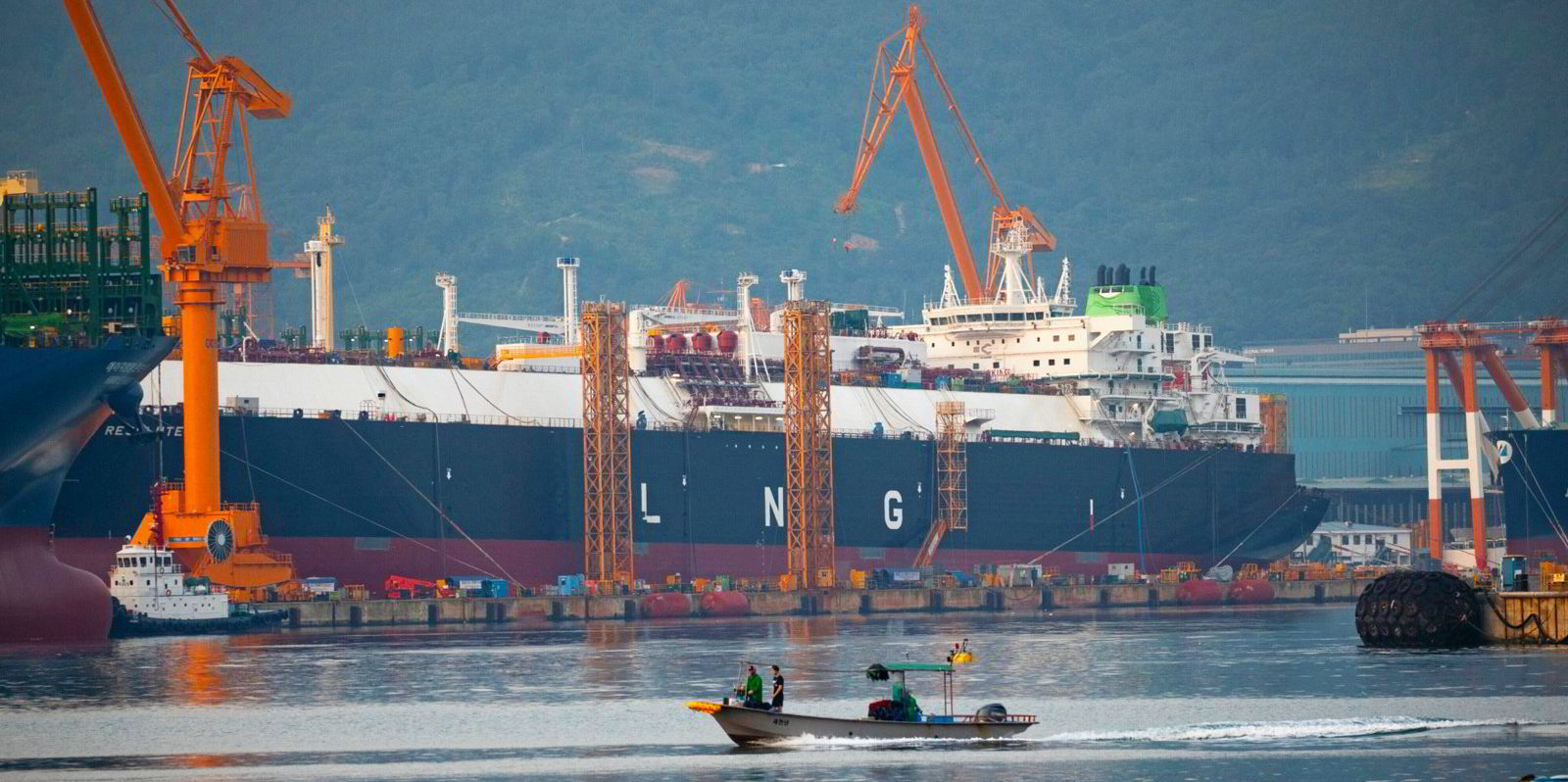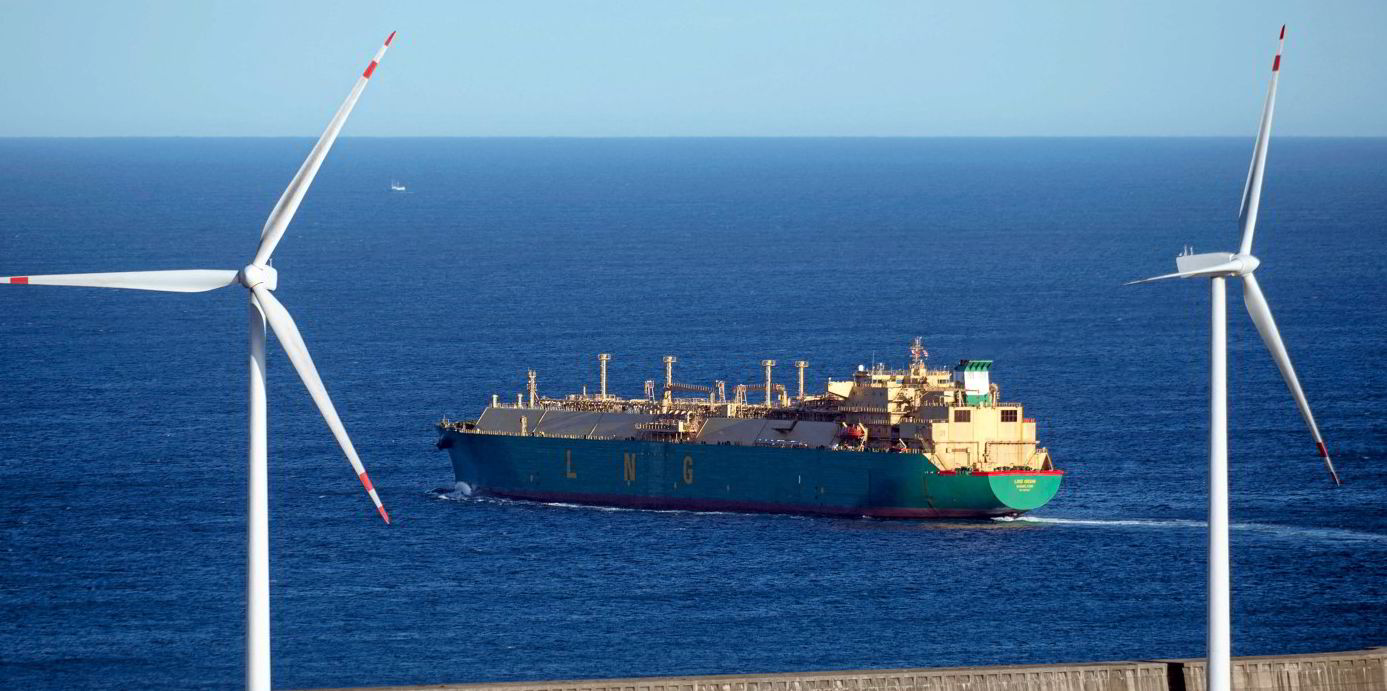LNG shipping has been a growth story that looks to be on track for another spurt.
Ten years ago, the LNG carrier fleet numbered 374 vessels, the standard 160,000-cbm newbuilding cost $198.5m and there were 96 ships on order.
Today, the fleet has ballooned to 720 ships with just over 300 on order at the end of March and the most recent prices for workhorse 174,000-cbm newbuildings are almost $260m.
Clarksons Research managing director Stephen Gordon says the number of large LNG carriers of more than 40,000 cbm is set to overtake the VLCC fleet by the end of 2026.

“The yards may well be building as many LNG vessels as they can for the rest of the decade and so we project the fleet could be over 1,130 large LNG carriers by 2033,” he adds.
Russia’s invasion of Ukraine in February 2022 prompted a dramatic and speedy trade shift. European buyers lurched sideways from their focused quest towards greener energy sources to shore up security of supply by importing LNG as a quick-fix alternative to Russian pipeline gas.
With Asian buyers continuing to buy long-term volumes and emerging economies expected to be in the market for cargoes if pricing proves competitive with other fuels, LNG project developers are seeing a pick-up in demand and prospects.
But the sector is caught in a pincer movement. LNG is seen as a carbon- and methane-emitting fossil fuel in one camp and a necessary transition fuel in the other.
Supporters argue for the carbon emissions reductions it already offers — up to 21% on a well-to-wake basis when used as a marine fuel — and point to a greener pathway forward through first bio-LNG and then synthetic LNG alternatives that can use existing infrastructure.
But its detractors flag up the fuel’s methane emissions — a more potent greenhouse gas than CO2 over both 20 and 100 years — and argue that investment should be going to renewables and developing the hydrogen economy.
It is no surprise that burning questions remain for LNG shipping over the next 10 years.

How long will LNG demand be sustained?
Underpinning all forecasts about the sector is how long LNG will remain part of the global energy mix.
In its LNG Outlook 2023, Shell said total global trade reached 397m tonnes in 2022, with demand forecast to reach more than 700m tonnes by 2040.
Gordon says: “For LNG trade we expect strong growth and perhaps 650m tonnes in 2030 — 675m tonnes in a higher case — and 690m tonnes by 2033 or 740m tonnes in a higher case.”
The International Energy Agency (IEA) and BP’s annual statistical review took scenario-based approaches, underscoring the level of unknowns in the market.
Under the IEA’s high-case scenario, which accounts for what governments and companies have said they will do to cut greenhouse gas emissions, LNG demand grows steadily to about 625m tonnes by 2050.
If states do all they have pledged to do on time, then demand peaks at around 530m tonnes in 2030, before falling to just shy of today’s levels at between 380m tonnes and 390m tonnes by 2050.
If the world achieves the 1.5°C stabilisation rise in global temperature, the IEA thinks LNG demand will peak in 2025 and falling to about 160m tonnes by 2050.
That is a long way from BP’s recent bullish pronouncements on LNG trade growth, which commentators say have shifted the needle towards greater production at the expense of investments in greener alternatives.
Executive vice president of trading & shipping Carol Howle says BP’s LNG supply will expand from 19m tonnes per annum in 2022 to 25 mtpa by 2025 and 30 mtpa by 2030.
In its energy outlook for 2023, BP forecasts a strong increase in LNG trade for the rest of this decade as emerging markets switch away from coal. But it says conflicting forces make the outlook “uncertain” from 2030 onwards.
In its low-case scenario, BP forecasts LNG demand slowing in the later 2020s and flattening by 2035 to fall below current levels by 2050 or earlier.
The company’s mid-case view shows demand slowing into the start of the 2030s. But in its high case, demand grows through into the 2040s before levelling off.

Consultant Andy Flower thinks the true picture will be a little below the energy majors’ “slightly wishful thinking” on demand, but acknowledges the level of uncertainty: “By early 2030, demand could be anything from 400m tonnes to 700m tonnes of LNG.”
On the supply side, Flower says that by the 2040s, around 80% of LNG could come from just two producing nations — Qatar and the US.

How many LNG carriers will be needed in the next 10 years?
It is the number that everyone wants to know, but so many variables dictate it.
French LNG cargo containment system designer GTT says up to 450 new vessels will be needed in the coming decade to meet expected growth in demand.
Some of this is already under construction, with two new projects officially greenlighted this year, others less formally so and with more final investment decisions expected in 2023.
These projects, many of them in the US, are due to start coming online from 2026, and as one consultant points out, they will be built on finance that envisages them operating for 20 years and beyond.
But GTT believes demand for LNG carriers will grow even faster than LNG due to the acceleration of fleet replacement from tougher environmental and emissions regulations.
Fearnley LNG team leader Per Christian Fett says the brokerage’s figures chime with those of GTT. Until around 2030, he says, shipyards will probably need to build between 70 and 80 newbuildings per year to cover fleet replacement and trade growth.
“It is not an extreme growth on an annual basis. I think it’s manageable,” he says, while acknowledging that other ship types will also be fighting for berth space.
There will still be more than 200 steam turbine ships in the market and they will increasingly struggle from an emissions and environmental perspective. “We’ll have to retire some of the vintage vessels at least from active service,” Fett adds.
He recalls that the LNG fleet numbered 93 ships when he started work in the sector. Today, he says it will definitely pass the 1,000-ship mark before the end of this decade.
Fett sees new liquefaction coming onstream in 2026 to 2028, making LNG more available and potentially affordable for Asian buyers. Volumes shipped longer-haul from the US will have a tonne-mile effect.
With Europe pivoting towards LNG imports in the wake of the invasion of Ukraine and the suspension of Russia’s pipeline gas supplies, the Fearnley team believes the trade will become even more seasonal, with Asian and European buyers competing for winter cargoes.
“We probably need to build ships that don’t only sail from A to B but also store LNG efficiently,” Fett says, with lower cargo boil-off rates and onboard reliquefaction plants among the options to enable this.
But one senior consultant says: “Until the question of how long LNG will be used as a transition fuel is answered, I don’t see how owners can take the risk of ordering any more ships without firm contracts that would take the ship amortisation to scrap at end of contract.”

How might LNG carrier designs change?
Emissions reductions are going to dominate design changes to vessels as owners and operators strive for regulatory compliance.
Lloyd’s Register global gas segment director Panos Mitrou says the classification society is about to start a new LNG “ship of the future” project.
Mitrou stresses that LNG shipping will not be a great space for investment in alternative fuels because the vessels need to manage their cargo boil-off gas and have this available as fuel.
The addition of a blend of bio-LNG or synthetic LNG is an obvious first call, but shipowners will need to apply abatement solutions to remain compliant with emissions regulations, he adds.
Forecasting that onboard methane abatement will be a feature of vessels 10 years from now is almost unanimous among commentators.
“Methane abatement is going to be an absolute necessity and we need to build ships that will be methane-proof,” Mitrou says of propulsion systems and cargo operations.
Opinions are more mixed regarding onboard carbon capture and storage (CCS). Some observers argue that the technology is still immature, will consume large amounts of energy and there are few reception facilities for the CO2.
Mitrou regards onboard CCS as “very promising” and probably cheaper and less disruptive than a clean fuel solution.
He floats the use of pre-combustion carbon capture with methane crackers and the use of hydrogen on board, potentially with the replacement of internal combustion engines with fuel cells.
Further cargo boil-off rate reduction is another possible development for LNG carriers, possibly down to a boil-off rate of 0.05% of the cargo volume per day. But Mitrou doubts it will move beyond this, given current materials pricing.
Could changing patterns bring an appetite for yet larger LNG carriers? QatarEnergy is weighing up building a new generation of massive 265,000-cbm Q-Max vessels. But at present the 174,000-cbm ship remains the modern workhorse.
A three-cargo tank vessel has also been proposed that could offer a lower boil-off rate while reducing newbuilding costs.
Fett says Fearnley has seen interest in the 200,000-cbm size, but largely from long-term rather than trading buyers.
He sees its advantages for long-haul trades where the vessel will also give lower emissions per cubic metre. But as the sector commoditises, he believes the focus will remain around ships of 174,000 cbm.




